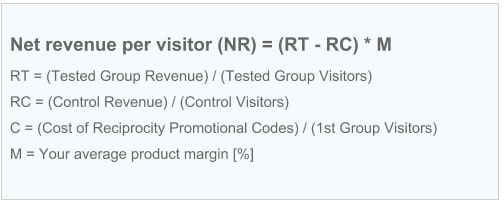
As a company that builds an advanced promotion system every day, we often get questions about ready recipes for efficient discount marketing strategies. The fact is, I can’t give you any ready-to-go list of to-do’s, and I can’t even say if discount marketing is what your brand currently needs. Every business is unique and consequently requires a unique approach. However, what I can do, and want to do in this post, is to show you which promotion types you should test to find an appropriate discounting strategy for your business. You’ll also see how to measure your efforts and estimate the performance of each discount. I can't wait to share these tactics with you, so let's dive in.
Discount marketing is the use of discounts to attract and convert customers by temporarily decreasing the price of a good or service for a limited amount of time. The most popular types of discounts include holiday specials, flash sales, volume discounts, or sign-up offers. For a complete list of sales promotions, check out our post of 30+ discount types.
In Voucherify, we understand discount marketing as the use of six promotion tools – coupons, cart discounts, referral and loyalty programs, gift cards, and giveaways.
Like any marketing strategy, discounting carries several pros and cons you should be aware of. To discount or not to discount? And the answer is... it depends. It doesn’t mean you need to fight a battle that may end with a costly loss to figure it out. The key is having a well-planned discounting strategy based on empirical results. Tests are the only right way to verify how your audience interacts with different types of promotions and discounts.
Here is a high-level overview of what goals you can achieve by having an appropriate discounting strategy in place:
What about the negatives then?
The most important factor to succeed with discount marketing is finding the right discount type, value, and additional limits carried by the promotion. To arrive at that phase, you first need to test various strategies to learn what works for you.
You should start with small campaigns of unique coupon codes carrying various values and rules. Moreover, you need to divide your current audience into groups and offer only one type of a coupon at a time. Results can be estimated with the following formula:
Now, do some simple calculations:

NR above $0 means you have run a profitable discount campaign and the discount worked out. Of course, for more accurate feedback, you need to use more advanced algorithms with more specific data, but this one is perfect when you are starting out with your discount marketing strategy.
Of course, more tests give more credible clues for the future, so you should treat all discount marketing efforts as separate tests. In the beginning, it's good to test different discounts through unique codes as they can be tracked easily. Later, you can roll out more complex scenarios such as referral or loyalty programs.
Coupons are very flexible promotion tools and enable you to tailor discounts to the specific goal and target group. Although, keep in mind, that versatility brings a vast amount of possible campaigns, so you need patience and time to find discounts that will perform well for you.
Knowing that 92% of consumers used a coupon on a purchase in the past year, you are well aware that testing discounts is worth your time and effort.
When you finally find the perfect formula for your strategy, you need to strategize how it will reach customers. After all, discount marketing can only work when customers know about it.
The communication channels you will use depend on multiple factors – the target group, product promoted, the value and type of incentive, and so on. Also, you should take into account the scope and intensity of the campaign (i.e. the frequency of broadcasting, the number of viewers, listeners), as well as its impact on a specific recipient. After all, there is no point in promoting discounts on women’s shoes in an exclusive men's magazine or a luxury car in a youth magazine.
Product bundling occurs when retailers sell lots of items bundled together while providing consumers with a discount at the same time. Popular BOGO offers (buy one get one) and bundles do wonders for increasing brand loyalty and preventing customers from drifting off to your competition. For instance, you can offer bulk packages of products or services. Such a strategy makes it more likely that customers will purchase more from you up-front and lengthen the period of product usage increasing their trust in your brand.

You may split your customer journey into more stages, that just focusing on acquisition, conversion, retention or re-engagement. To strengthen the customer experience and increase the success rate of your discounts, you should incorporate them into unique moments in your funnel. Some examples of unique customer moments include:
After you define the type and the value of your offer, you should think about eligibility conditions. By introducing limits, you can effectively safeguard your offers against fraud, but also release discounts that are more personalized and budget-friendly. Here are some examples of discount limits that you can use:
If you are interested in a complete guide to coupon marketing strategy, check this out.
Now, let’s break down five most popular discount strategies to help you get started with your discounting plan.
A sign-up discount is what many companies offer their potential customers. However, in the case of new visitors, it’s impossible to use personalized incentives or provide relevant targeting straight away. Truth is, you don’t know anything about new users until they decide to share their data with you. We recommend starting by checking the performance of different discount variants before you decide which one should be your standard sign-up offer. An example schedule could look like this:
This schema repeated through several weeks should give you credible clues. Meanwhile, you can test, not only the discount type and value, but also the best performing channels (emails, SMS, live chat, etc.) and discount timeframes.
Remember to equip all the discount codes and auto-applied promotions with expiration dates. Codes valid only within a short time window are a great tactic to make customers purchase now instead of later (or never).
Another thing you could do to make your sign-up discount more effective is to create a new design for your welcome message. Imagine you sent an email to a potential customer with a 10% discount on everything. Besides warm welcomes and a coupon code, he/she gets a P.S. with a list of all active promotions. Even if your typical welcome discount doesn’t convince a customer to purchase, another one might do the job. A client may think standard that 10% off everything is not enough to make a purchase, but 20% off a specific product he/she is interested in is definitely worth it. By selecting proper discount strategy, you're increasing your chances of great ROI coming from your coupon campaigns.
Referral programs can bring in new customers and improve customer retention. To make it possible, referral rewards and program rules should be consistent with the dynamics of your sales. If you sell products needed once per couple of years, coupons for a second purchase will fail with a high probability. On the other hand, if your services are used day-to-day, rewarding each time a new customer is referred may be expensive.
In the first case, consider collaboration with other brands, which may be attractive to your customers. You can offer gift cards for their services or coupon codes for free products. Stores with everyday products may use gamification to gain more interest and higher customer engagement. You can use a multi-level reward schema or social media to bring more life into your referral strategy.
Customers can be rewarded if their referrals help you acquire new customers, and also it helps you to spread your offering via word-of-mouth. For example, you can offer a 20% discount for customers who refer at least three clients (who purchased) and an additional 5% discount if the referred customers shared your social post. Ultimately, a reward ladder should engage customers with more and more attractive rewards.
Referral marketing requires advanced tracking to keep it under control. No matter the discount type, remember to use unique codes that can be assigned to particular users and tracked to measure the number of referrals. In the case of social media shares, use specific tags to manage referral activity of your customers.
Flash sales are dynamic discounts available in a limited time frame. Their whole point is to be fast and temporary. They can work well for customer retention if you learn how to use them correctly. First of all, short expiration dates. Such campaigns should be limited to one or two days maximum, preferably even to a couple hours. Recurring flash sales give your customers a good reason to visit your store regularly. You can send a message the day before a campaign fires off or launch it unexpectedly when the traffic is usually high.
Short dynamic campaigns are a significant part of discount marketing. They deliver an enormous amount of relevant data that you can use to model your long-term promotional strategy.
Building loyalty starts from the very first interaction between a customer and your brand. It requires lots of time and patience to convert new clients into loyal buyers. Discount marketing can be used as a tool to instill loyalty. Discount marketing is a part of most loyalty programs. However, before you define a program structure, you need to determine who your loyal customer is? Don't make the common mistake of trying to drag everyone into a program. That is not the point. Such a strategy often ends up as a budget burner.
Loyal customers should be defined by the high revenue they bring you. The point is, to show them your appreciation and build strong relationships to not only keep regular customers but also gain brand advocates in the long run.
Discounts you prepare should be outstanding, personalized, and unavailable for customers outside the loyal segment. Moreover, the type of offer is as important as the way you present those offers to your loyal clients. Each message with a coupon code or gift card should create a feeling of getting something exclusive, far better than the standard version. For example, you can inform a customer in the message about the fact that only a few customers got the deal you have just sent them.
The role of the discount marketing in your loyalty program depends on how you design it. Although there is no silver bullet rule, we recommend the combination of personalized discounts with gamified experiences and a multi-level reward structure.
Besides the loyalty program, you can instill loyalty by celebrating the dates important to your customers. Using advanced personalization requires paying attention to particular customers and explains why you shouldn’t overextend your loyalty segment. Birthdays and anniversaries are a perfect way to surprise your best audience with a coupon code or gift card.
Even a birthday gift, which may seem like a standard idea in discount marketing, still may be a surprise that your customer will remember and appreciate. The key is to make your message personalized and the discount attractive. You may go through order history and figure out what discounts and products would fit each customer best.
Every great discount marketing strategy is built on hundred of tests and tweaks. There are no universal rules that guarantee you will succeed with your strategy. Nevertheless, the fact that companies we support come from such diversified market fields like transport, healthcare, travel, fitness, (and many more), proves that discounts can be effective no matter the business type or size. You can read their stories here.